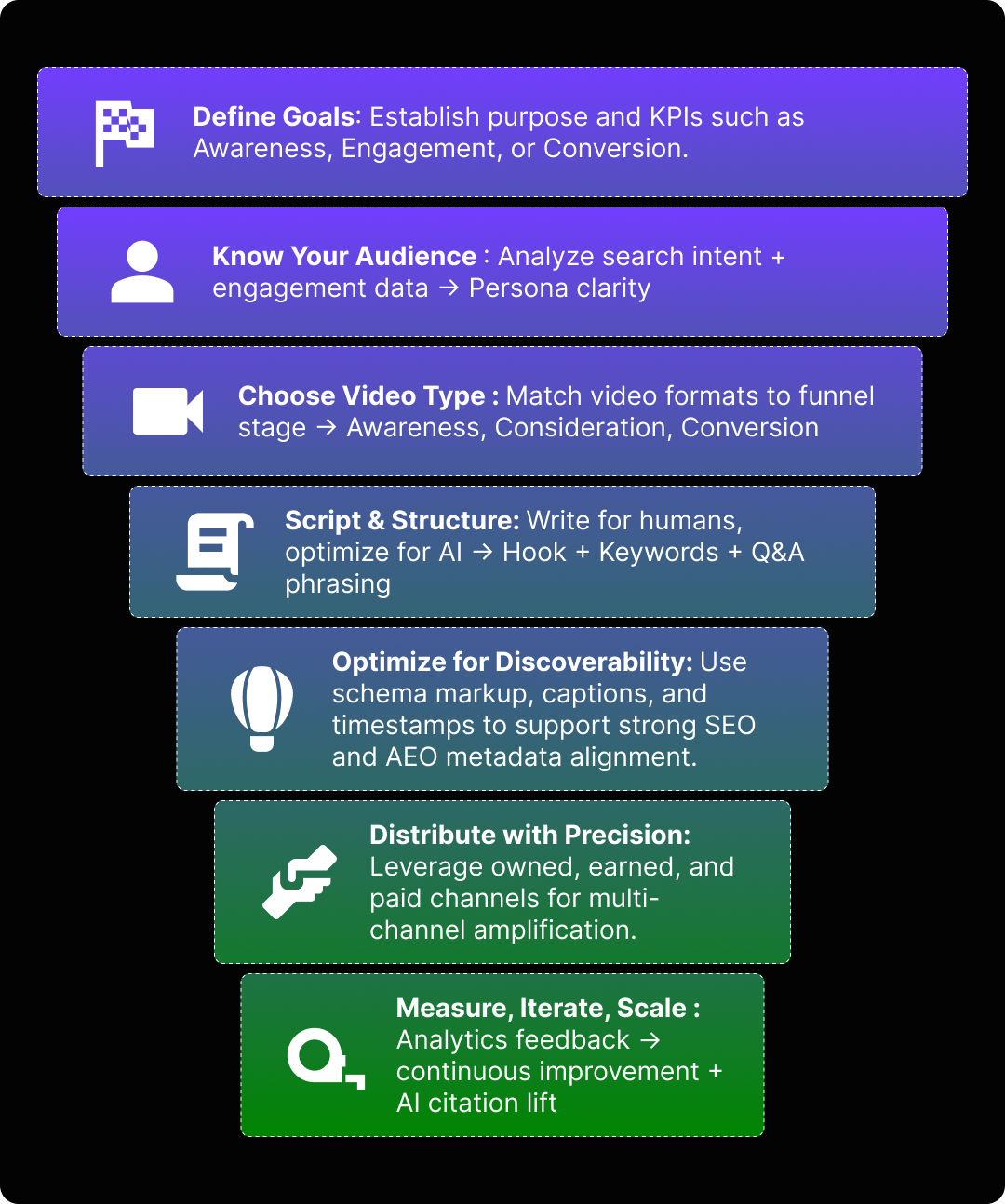Video is something like the internet’s universal language.
Whether it’s a TikTok, a YouTube explainer, or a LinkedIn clip, motion is how audiences discover, learn, and decide. Search engines and AI models know it too, and they’re rewarding brands that use video strategically.
I’m here to tell you how video marketing has evolved from creative storytelling to a core growth engine for visibility and conversions. Because in 2026, it’s not just about being watched, but getting found, cited, and trusted in every place where your audience searches.
Why Video Marketing Matters More Than Ever
Video is the internet’s dominant language.
Nearly every major platform and algorithm (from Google Search to TikTok to AI engines like Gemini and Perplexity) prioritizes video-first content because users do too.
And the data backs it up: nearly 9 in 10 businesses use video as a marketing tool, and over half of mobile search results include some form of video content. Google also displays video thumbnails in roughly one in four search results, and video carousels and Shorts are appearing in more queries than ever before (Shorts even got its own fancy tab within Google).
And this isn’t just a cosmetic SERP facelift. Google and AI systems increasingly rely on engagement signals, dwell time, and semantic context, making video one of the most powerful tools for brands to boost visibility, credibility, and conversion, simultaneously fueling both SEO and AEO performance.
Whether it’s a 15-second TikTok with an engaging hook, or a 5-minute YouTube deep dive, video is the connective tissue between brand discovery, algorithmic visibility, and customer action.
Video Dominates Search Results
Once upon a time, ranking meant claiming a spot as one of the top 10 blue links. Today, it means owning every surface of search, with video sitting at the top of nearly all of them.
With traditional SEO, Google continues to give video results prime real estate in the SERP through video carousels, thumbnails, and featured snippets. Studies show that video appears in over half of mobile SERPs, and Google displays video thumbnails in roughly one-quarter of all search results.
This is obviously important for visibility, but it’s also about how video impacts the metrics Google cares about most:
- Dwell Time: People spend longer on pages with embedded videos.
- Engagement Rate: Video reduces bounce and increases scroll depth.
- CTR: Thumbnails naturally pull the eye, earning more clicks than plain text results.
Each of these metrics sends positive signals back to Google’s ranking systems, reinforcing the fact that your content satisfies search intent.
… and then there’s AEO: the new frontier of visibility.
Large language models (LLMs) like Gemini and ChatGPT increasingly pull from video transcripts and metadata to inform their summaries. When users ask questions that begin with how, what, or best, AI engines often surface YouTube videos as cited sources, effectively giving optimized videos double the reach: once on the SERP, and again inside AI search results.
Between AI search and social search, that’s why the smartest brands are testing every video as a search asset, not just a social one.
When you upload a video with a clear title, keyword-rich transcript, and timestamped sections, you’re feeding both Google’s crawler and AI’s contextual models. It’s visibility that compounds and proof that video marketing is just as technical as it is creative.
User Behavior Has Shifted
People aren’t just scrolling. They’re streaming.
From TikTok to YouTube Shorts to LinkedIn’s new vertical video feed, users today move through content expecting motion, sound, and story. Static text can inform, but video performs: it entertains, explains, and convinces in a single scroll.
Let the numbers below paint a clearer picture:
- 82% of global internet traffic now comes from video consumption.
- 48% of Gen Z and Millennials say they discover new brands through short-form videos before ever Googling them.
- And across industries, 88% of people report being convinced to buy a product or service after watching a brand’s video.
This behavior is reshaping the marketing funnel right before our very eyes.
Where awareness, consideration, and conversion were once distinct, linear phases, video compresses all three into a single experience: a 30-second clip that introduces your brand, demonstrates your value, and drives users to an immediate action.
Even in B2B, motion has become the medium of trust.
A founder explaining their product on camera outperforms a static whitepaper; a video testimonial feels more credible than a block of text. Viewers retain up to 95% of a message when watching a video compared to 10% when reading text, and video testimonials are consistently rated as more believable because tone and facial cues convey authenticity.
As marketers, we need to rethink content not as funnels of pages, but instead as sequences of visual touchpoints.
Every video your brand creates acts as a behavioural signal, reinforcing relevance in Google’s and AI engines’ eyes; increasing your chances of ranking higher, getting cited in Google’s AI Overview, and winning both the click and the customer. Think of motion as the new default dialect of digital discovery.
Video Fuels AI Understanding
AI doesn’t “watch” your videos, but it is reading them.
Modern search engines and large language models (LLMs) like Google Gemini, ChatGPT, and Perplexity parse video transcripts, captions, metadata, and structured data to understand what your content is about and determine when to surface it in results.
When you upload a video with accurate captions, descriptive titles, and timestamps, you’re not just improving accessibility; you’re also training AI to associate your content with relevant queries.
How AI Interprets Video Content
- Crawlers extract textual data: Search crawlers and AI models read your video’s title, description, and transcript. They use this to classify topics, intent, and expertise; similar to how they index blog posts.
- Structured data tells AI what your video is: Adding VideoObject schema helps Google and AI engines identify details like duration, upload date, thumbnail, and key moments. This data improves eligibility for video-rich snippets and AI citations.
- Transcripts fuel generative summaries: AI systems rely on text data (not visuals) to generate answers. So if your transcript contains natural, question-driven phrasing (like “How does this product work?” or “What’s the best way to…”), your video is more likely to appear as a source in AI Overviews.
- Engagement signals reinforce relevance: Metrics like watch time, replay rate, and completion percentage tell both Google and LLMs that users find your video valuable. Those behavioral signals strengthen your domain’s overall authority in search ecosystems.
Why This Matters for AEO
Answer Engine Optimization (AEO) thrives on content that clearly satisfies intent.
AI Overviews and conversational engines like ChatGPT surface YouTube videos as citations in answers, especially for “how-to,” “tutorial,” and “review” queries. GoDataFeed’s study found that video citations in Google’s AI Overviews have surged 25% year-over-year, demonstrating how quickly visual content has become a part of AI’s knowledge base.
This means that every video your brand publishes isn’t just competing for clicks, but also competing for citations. When your brand’s videos consistently appear in AI summaries and generative snippets, you’re effectively earning what I like to call “the new backlink”: a co-citation from the algorithm itself.
Bottom line: AI may not care about your B-roll or lighting setup, but it does care about your clarity, structure, and viewer engagement. Optimizing those elements ensures your videos are not only watched, but understood, cited, and surfaced across the next generation of search.
Steps to a Winning Video Marketing Strategy

Anyone can make a video. But building a video strategy that drives traffic, engagement, and conversion across both search engines and AI models takes more than just a camera and script.
Here’s a sneak peek into NoGood’s approach:
Step 1: Define Your Goal Before Hitting Record
Video isn’t simply a deliverable; it’s a growth lever.
Every high-performing video begins with a measurable goal: awareness, engagement, lead generation, or conversion. Each outcome determines everything from format and runtime to distribution and creative tone.
For example:
- Awareness: Short-form, high-frequency videos for social reach and brand recall.
- Consideration: Explainers, tutorials, or founder-led content that builds authority.
- Conversion: Product demos, customer stories, and retargeting sequences.
From an SEO and AEO lens, aligning video goals with intent categories (informational, comparative, transactional) ensures your content reaches users at the right search moment.
Step 2: Understand (& Quantify) Your Audience
Your viewers are demographics and data, and should be used as such.
Use insights from search intent, engagement analytics, and AI-generated audience clusters to identify what topics, tones, and formats resonate.
At NoGood, we map audience data from:
- YouTube Studio (watch time, audience retention, CTR)
- Google Analytics + UTM tracking (session value and conversion attribution)
- Goodie’s Topic Explorer (semantic clusters that surface what users actually ask AI tools)
This approach ensures your next video isn’t based on gut instinct but backed by how your audience already behaves across search and AI surfaces. If you’re still guessing what your audience wants to watch, AI already knows what they’re asking.
Step 3: Choose the Right Video Type for the Job
There’s no one-size-fits-all format, but every video has a clear purpose in the growth engine.
Here’s how we frame it at NoGood:
| Objective | Best Video Type | Platform Example | AEO / SEO Advantage |
| Build Awareness | Short-form, founder clips, motion graphics | TikTok, Reels, Shorts | High engagement → stronger AI visibility |
| Educate or Compare | Explainers, tutorials, webinars | YouTube, blog embeds | Rich transcripts → higher SERP / AEO citation chance |
| Convert | Testimonials, demos, walk-throughs | YouTube, landing pages | Emotional proof + structured data = trust |
| Retain | Community updates, product tips | Email, owned media | Boosts brand familiarity and return engagement |
The smartest brands diversify content across the funnel so their videos feed multiple ecosystems: organic, paid, and AI-driven.
Step 4: Script for Humans, Structure for Machines
Storytelling still wins hearts, but structure wins rankings.
A great video script does both:
- Hooks the viewer in the first 3 seconds (to satisfy engagement metrics)
- Incorporates natural, conversational keywords early (to signal topic relevance)
- Mirrors Q&A phrasing that LLMs can easily parse (“How does X work?” “What’s the best Y?”)
Transcripts, captions, and titles all become semantic assets for AEO and SEO, giving AI models text to read, index, and cite. Think of every line in your video as metadata with personality.
Step 5: Design for Discoverability
The algorithm isn’t guessing; it’s reading.
Optimizing discoverability means making it easy for Google and AI to understand, categorize, and surface your videos.
Use this checklist:

When combined, this boosts your chances of appearing in video-rich results, AI Overviews, and People Also Ask sections; the new “top of funnel” surfaces.
Step 6: Distribute With Precision
Having the best video in the world means nothing if no one sees it. Something something bear sh*ts in the woods. Distribution is where creative meets performance.
Think of video distribution in three strategic layers:
- Owned: Embed on your site and landing pages to improve dwell time and SEO signals.
- Earned: Publish natively on YouTube, LinkedIn, and TikTok for algorithmic reach.
- Paid: Retarget engaged viewers and custom audiences via Meta, Google Ads, and programmatic placements.
Each layer should ladder into measurable KPIs (reach, engagement, conversion) all tracked via UTMs and video analytics so you can attribute ROI, not just impressions. Remember folks, your goal isn’t just to reach, but repeatability.
Step 7: Measure, Iterate & Scale
Data is the post-production that never ends.
Use analytics to aid in continuously refining your content for the people and the algorithm.
Track:
- Engagement metrics: Watch time, completion rate, replay percentage
- Conversion metrics: Clicks, leads, assisted revenue
- Visibility metrics: SERP placement, AI citations, co-occurrence rate
Our clients and NoGood often see compounding gains once their video libraries get a little AEO touch-up, because LLMs favor consistent, credible brands. The more AI understands you, the more often it recommends you. In the age of AI search, the most visible brand isn’t the loudest; it’s the one that’s easiest for machines to trust.
Long-Form vs. Short-Form: Which Wins in 2026?
The battle between long-form and short-form is long-standing, but the question we should be asking ourselves is: which one wins where?
Each format serves a different purpose in your marketing ecosystem, and when used strategically, they actually fuel each other. Think of them as your dynamic growth duo: short-form attracts, long-form converts.
Short-Form: The Attention Magnet
Short-form content (under 60 seconds) dominates the discovery stage, and for good reason.
Algorithms love it, users can’t stop scrolling it, Google now indexes it, and even AI engines are starting to cite it.
Platforms like TikTok, YouTube Shorts, and Instagram Reels now double as search engines in their own right. TikTok SEO queries like “best budget headset” or “how to make cold brew” generate billions of views, and Google’s search results increasingly embed these same clips in video carousels and AI Overviews.
Why it matters for visibility:
- Short-form videos earn higher engagement rates than any other content format.
- Google’s AI systems are favoring bite-sized explainer videos in its AI Overviews for “how-to” and “product review” queries.
- Short-form videos often appear on multiple surfaces simultaneously, social feeds, YouTube Shorts, and search snippets, compounding reach across ecosystems.
Why it matters for performance:
- Quick storytelling formats drive top-of-funnel awareness and brand recall.
- The same short clip can be repurposed across every major platform with minor tweaks. It’s efficiency that scales.
- They’re perfect for capturing emerging demand in AI and social search, where the first 5 seconds decide your fate.
Think of short-form as the spark that gets you noticed, but not necessarily the flame that closes the deal.
Long-Form: The Authority Builder
Long-form video (2-10 minutes) is where you build depth, trust, and ranking power.
It’s ideal for education, comparison, and consideration-stage content, where users want more than a scroll’s worth of information before committing.
Why it matters for visibility:
- YouTube remains the second-largest search engine in the world and dominates video results in Google SERPs.
- Long-form content gives AI models more transcript data to interpret, meaning better chances of being summarized, cited, or linked within AI-generated answers.
- Longer videos also perform better in Google’s “key moments” feature (the timestamped highlights box), which helps you own more real estate on SERPs.
Why it matters for performance:
- Viewers who finish long-form videos are 2.6x more likely to convert than those who only watch short clips.
- Tutorials, webinars, and explainer videos increase perceived brand authority, crucial for B2B and high-consideration products.
- They drive longer session durations on your site or YouTube channel, a positive ranking signal in both SEO and AEO.
If short-form earns attention, long-form earns trust. And trust converts.
How Short-Form & Long-Form Video Content Work Together
Don’t just choose between them; stack them.
Here’s how:
| Funnel Stage | Recommended Format | Example Content | Search / AEO Benefit |
| Awareness | Short-form (15-45s) | Quick tips, product teasers, UGC | High engagement → visibility across AI and social |
| Consideration | Mid-form (1-3m) | Explainers, product walk-throughs | Transcript depth → better AI understanding |
| Decision | Long-form (5-10m) | Demos, testimonials, webinars | Strong context → higher trust and conversion |
| Retention | Short-form (15-45s) | Tutorials, feature updates | Repeat engagement → improved brand familiarity |
Short-form videos feed traffic into your long-form content, while long-form anchors your domain authority and AI visibility. Together, they form a full-cycle strategy: attract → educate → convert → retain.
Bottom Line
Thinking short vs. long is so 2022. We need to reframe this binary and think surface vs. depth.
Short-form makes algorithms notice you; long-form makes AI remember you. And when your brand’s video ecosystem includes both, you’re owning every level of the video marketing game.
How to Optimize Videos for SEO + AEO
Just like optimizing written content, video content should also be optimized for SEO and AEO. We mentioned how search algorithms aren’t “watching” videos like users do, so this means you need to blatantly hand over metadata, transcripts, and behavioral signals to show these engines exactly what your content means and why this matters for searchers.
Every frame, caption, and click must be engineered for visibility. Here’s how to do it:
1. Start With Intent, Not Keywords
Traditional SEO begins with keyword targeting. Video optimization starts with intent targeting.
Before you even hit record, ask:
- What question should this video answer?
- Is the viewer searching to learn, compare, or buy?
- How would they phrase that query in a search bar or AI chat?
This approach ensures your video content aligns with AI’s semantic understanding, which favors context (“best budget headset for streaming”) over raw keyword density (“budget headset review”). In AEO, it’s not what you say; it’s how your audience would ask for it.
2. Optimize Metadata for Both Humans & Machines
We emphasized how important metadata is earlier in the article, but here’s why: metadata is your video’s handshake with the algorithm. Every title, description, and tag should be written for two audiences: people and parsing systems.
Here are some best practices:
- Titles: Lead with value or outcome (“How to Build a Video Marketing Strategy That Converts”).
- Descriptions: Front-load your main topic and include timestamps or chapters.
- Tags: Use variations of your main keyword + related entities (e.g., “video strategy,” “AI SEO,” “content funnel”).
- Thumbnails: Add visual consistency (same colors, font, logo) to strengthen brand recognition across platforms.
Strong metadata increases click-through rate and helps search engines connect your video to related queries, improving discoverability across SERPs, YouTube, and AI Overviews.
3. Add Transcripts & Captions (They’re Your Secret SEO Weapon)
Transcripts are extremely important for ensuring accessibility amongst users, but they also work to make your content searchable.
When uploaded natively or embedded on your site, transcripts give Google and AI engines the text they need to understand, index, and summarize your video.
Why it matters:
- Google indexes captions to interpret topic relevance.
- AI systems like Gemini and ChatGPT use transcripts to generate summaries or citations.
- Users who read along stay engaged longer, boosting watch time and dwell rate.
If your video doesn’t have a transcript, it may as well be invisible to search engines.
4. Use Structured Data to Claim Your Space in Search
Structured data is another point I would like to reiterate on. Schema markup is your backstage pass to Google’s rich results. By adding VideoObject schema to your site embeds, you make it easier for search engines to display your videos in carousels, thumbnails, and AI-generated snippets.
Include these key properties:

Bonus points: If you mark up key timestamps (“Step 1: Set Goals,” “Step 2: Choose Format”), your video becomes eligible for “key moments” in Google results, one of the most visible features for long-form video.
5. Embed Videos on High-Authority Pages
Google prioritizes context-rich embeddings, meaning videos placed on relevant, optimized pages perform better than standalone uploads.
Embedding videos on your blog or landing pages:
- Increases dwell time (a positive ranking signal)
- Reinforces topical authority
- Creates multi-layered signals between your site content, schema, and video metadata
Make sure your page copy supports the same intent as your video. For AEO, that alignment between text and transcript improves co-occurrence, helping AI engines associate your brand with that topic in future answers.
6. Track Engagement Metrics That Matter
Algorithms evolve, but they all reward engagement.
The most important metrics to monitor:

Feed this data back into your strategy. The stronger your engagement signals, the more AI systems interpret your videos as high-quality, trustworthy sources, increasing citations and visibility.
7. Repurpose & Reconnect
Once your video is optimized, don’t let it collect digital dust. Cut it into short clips for social, turn transcripts into blog posts, or build carousels from key insights. Each new asset links back to the original, creating cross-surface visibility loops that boost your brand’s semantic footprint across search and AI.
Every optimized video becomes a content nucleus with everything else orbiting around it.
From Views to Visibility (& Actual Conversions)
Video content is distribution, discovery, and decision-making wrapped into one format. When you script for humans, structure for machines, and distribute with intent, each video becomes a flywheel: it earns attention on social, authority on YouTube, rankings on Google, and citations inside AI results. That’s durable visibility.
Posting every day doesn’t mean you’ll win. You need a video ecosystem: short-form to spark demand, long-form to earn trust, transcripts and schema to make it machine-readable, and tight analytics to prove ROI. Do that consistently and you show up wherever customers ask questions, compare options, and decide.
Bottom line: Treat every video as a search asset, not a social post. Build for surface and depth. If you make it easy for people to watch and for AI to understand, the algorithms will do the heavy lifting.






